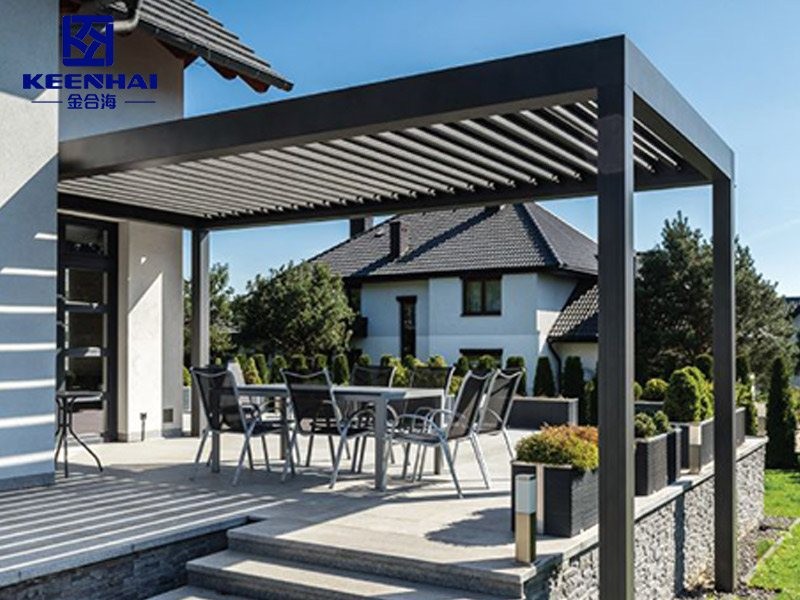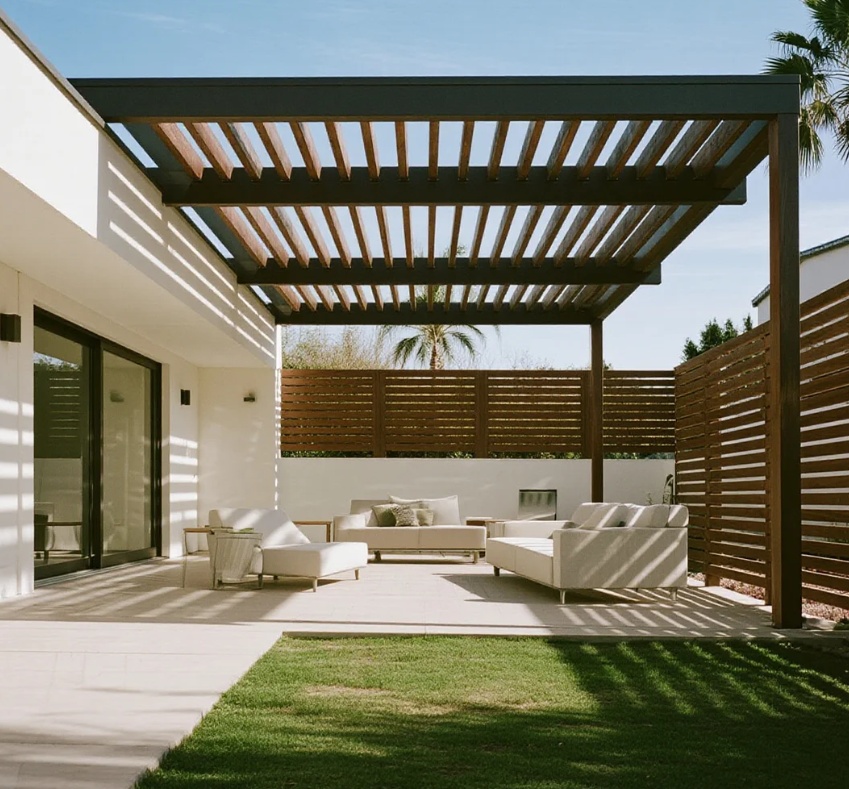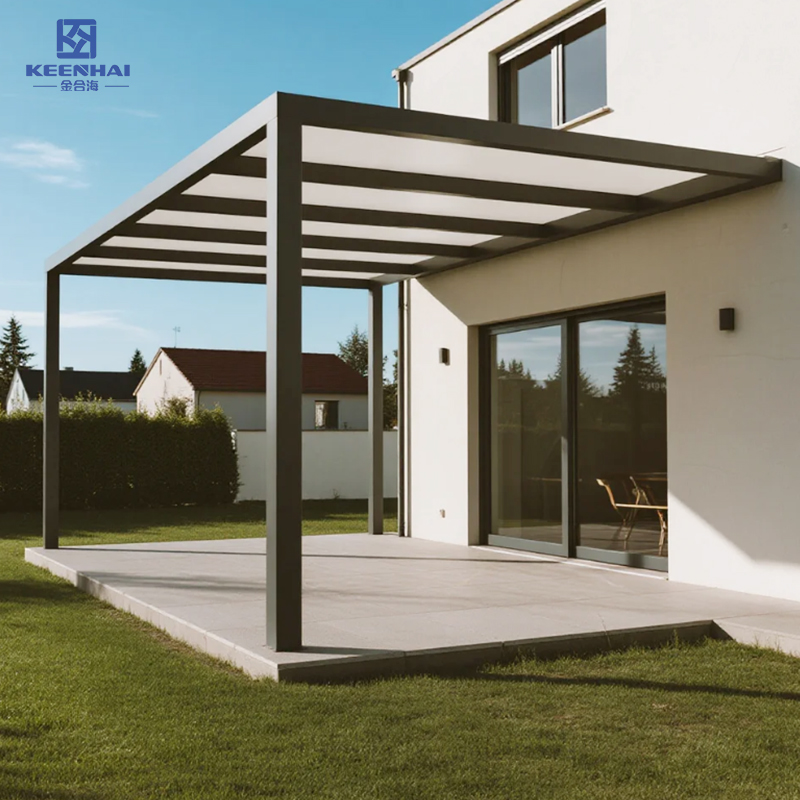
Average Price Ranges in 2025
Small Pergolas (10×10 ft)
In 2025, a compact 10×10 ft pergola remains one of the most affordable entry points for homeowners. The cost usually ranges from $6,000 to $9,500, and this variation comes from the materials, level of automation, and add-on features. The total price can be better understood if broken down into steps:
-
Material Selection – Wooden pergolas cost less, starting around $6,000. However, they demand seasonal treatment. On the other hand, an aluminum louvered pergola begins closer to $7,000 but lasts significantly longer without the need for repainting.
-
Roof System Choice – A simple slatted roof stays budget-friendly, but homeowners who want more functionality often choose an aluminum louvered roof gazebo. This adds about $1,500–$2,000, yet the adjustable louvers allow better control of sunlight and ventilation.
-
Motorization and Controls – Adding a motorized tilt system, remote control, or even smartphone integration increases usability. Consequently, this adds another $1,200–$1,800 to the overall investment.
-
Extra Features – For poolside use, special coatings are required to resist humidity and saltwater exposure. As a result, an aluminum poolside pergola usually starts at $9,000. Options such as LED strips or retractable side screens can push the budget further upward.
Therefore, while the “base” price sounds affordable, most buyers in 2025 find that once they include motorization and weatherproof finishes, a realistic budget for a 10×10 pergola is closer to $8,000–$9,500.
Medium Pergolas (10×13 ft, 12×16 ft)
Pergolas in the 10×13 ft to 12×16 ft range represent a balance between space and affordability. In 2025, they usually cost $10,000 to $16,000, with most homeowners choosing aluminum over wood due to structural strength. The investment can be explained step by step:
-
Frame and Size Expansion – The larger footprint naturally increases material usage and requires thicker support posts. This alone raises costs by about $3,000 compared to a small pergola.
-
Roof Engineering – A wider span demands stronger roof panels or reinforced louvers. A robust aluminum metal roof gazebo usually starts at $12,000 because it can handle wind loads and heavy rainfall better than wood.
-
Automation as Standard – At this size, homeowners almost always add motorization. Integrated sensors that detect rain and close the louvers automatically add convenience but also add $2,000–$3,500 to the bill.
-
Design and Finishes – Buyers increasingly match their pergolas with modern landscaping or outdoor kitchens. Premium powder coatings, multi-zone lighting, and wood-look aluminum finishes add another 15%–25% to the cost.
-
Brand Reputation – Homeowners are more selective in this segment, prioritizing quality and after-sales support. Reputable providers such as KeenhaiPergola are chosen because they deliver both customization and durability.
As a result, most medium-size pergolas average $12,000–$15,000 when factoring in motorization and finishes, even if the “starting price” is lower.
Large Custom Pergolas
When moving into the large category—16×20 ft or even bigger—pricing becomes highly variable. In 2025, costs usually begin around $18,000 and can exceed $35,000. Large-scale builds are almost always custom and involve multiple stages:
-
Engineering and Structural Design – A large louvered pergola requires reinforced posts, deeper footings, and thicker louvers. This engineering step alone accounts for $5,000–$7,000 of the budget.
-
Roof Technology – Oversized slats, hidden drainage, and storm-proofing significantly affect pricing. A motorized aluminum louvered roof gazebo with automatic weather sensors typically adds $4,000–$6,000.
-
Customization Options – High-end projects often include retractable glass walls, built-in sound systems, and heating solutions. For example, installing retractable privacy panels or insulated sliding glass can raise the budget by 30–40%.
-
Luxury Finishes – Wood-grain aluminum, multi-zone LED lighting, or fully concealed gutter systems create a seamless appearance. These upgrades, while optional, are popular in luxury homes and hospitality spaces.
-
Installation Complexity – Due to their size, large pergolas require heavy-duty equipment and a larger installation crew. This adds significant labor expenses, often $6,000–$10,000 alone.
Consequently, it is common for a high-end custom pergola to reach $25,000–$35,000, especially when designed as a centerpiece for a pool deck, restaurant, or resort.

Key Factors That Influence Pergola Cost
Materials (Aluminum vs Wood vs Steel)
The choice of material is the single biggest factor shaping pergola costs in 2025. Each material comes with different price ranges, maintenance needs, and durability.
-
Aluminum – This is the most popular material today. A basic aluminum frame starts at $7,000, but premium louvered pergola systems often cost $10,000 or more. Moreover, aluminum is corrosion-resistant, lightweight, and requires almost no yearly upkeep, making it ideal for humid or coastal regions.
-
Wood – Natural wood pergolas attract buyers looking for a traditional aesthetic. A cedar or redwood pergola starts at $6,000 for a small size. However, wood requires resealing every 2–3 years, and over a decade the maintenance adds thousands of dollars. In addition, termites or rot may shorten its lifespan if left untreated.
-
Steel – A steel pergola is the most expensive choice, often beginning at $15,000. Its strength allows for very large spans without extra posts. That said, steel needs professional coatings to resist rust, especially outdoors. Powder-coated steel with UV resistance can last decades but comes at a premium.
As a result, homeowners often pick aluminum because it balances upfront cost, aesthetics, and low maintenance.
Manual vs Motorized System
The way the roof operates also has a direct impact on pergola pricing.
-
Manual Systems – These use a hand crank or lever to adjust the louvers. The initial cost is lower, adding only $600–$1,000 compared to a fixed roof. However, they are less convenient, especially for larger pergolas.
-
Basic Motorized Louvers – Adding a small electric motor raises the budget by $1,200–$1,800. In addition, buyers often appreciate the convenience of opening or closing the pergola with a button.
-
Advanced Automation – In 2025, more people install smart systems that integrate with home automation apps. For example, a motorized aluminum louvered roof gazebo with rain sensors that close automatically during bad weather typically adds $3,000–$4,500.
While manual systems save money upfront, homeowners increasingly see motorization as a long-term investment in comfort.
Finish and Coatings
The finishing layer on a pergola is not just about looks; it also influences longevity and total cost.
-
Powder Coating – Most aluminum metal roof gazebos come with powder-coated finishes that resist scratching and fading. This treatment adds about $1,000–$1,500 but extends the pergola’s life dramatically.
-
Wood Staining – Natural wood pergolas require staining every few years. Each treatment may cost $500–$800, which means an additional $3,000–$4,000 over 10 years.
-
Specialty Coatings – For poolside or coastal installations, corrosion-resistant layers are essential. An aluminum poolside pergola usually comes with marine-grade finishes, adding $1,500–$2,500. Furthermore, UV-blocking coatings help preserve color under direct sunlight.
Therefore, coatings and finishes should not be treated as “optional extras.” They are a core part of protecting the investment.
Accessories (Lighting, Heaters, Screens)
Accessories transform a basic pergola into a multifunctional outdoor living space, but they also add significantly to cost.
-
Integrated Lighting – Built-in LED strips or spotlights usually cost $1,000–$2,000. In addition, some homeowners install dimmable smart lighting, which syncs with their phone apps.
-
Heating Units – Outdoor infrared heaters or gas-powered systems extend the usability of pergolas into colder months. Each heater adds $800–$1,200, and larger pergolas may require multiple units.
-
Screens and Side Panels – Retractable fabric or glass screens improve privacy and block wind. Depending on the material, they add anywhere from $2,000 to $5,000. For luxury builds, sliding glass walls can cost more than $10,000.
-
Audio and Smart Features – High-end buyers sometimes integrate speakers, Wi-Fi boosters, and automated shade controls. These luxury upgrades add $3,000–$6,000 to the budget.
Because accessories are modular, homeowners often start with lighting and motorization, then add heaters or screens later as their budget allows.

Installation and Labor Costs
Professional Contractor Pricing
Hiring a professional contractor is the most common choice for homeowners who want a secure and long-lasting pergola. In 2025, labor typically represents 25%–40% of the total budget, depending on the complexity of the project and regional labor rates.
-
Initial Site Preparation – Most contractors begin by preparing the foundation. This includes clearing vegetation, ensuring the ground is level, and pouring concrete footings. The groundwork alone can cost between $1,000 and $1,500, especially if the soil requires reinforcement.
-
Frame and Column Installation – After the foundation sets, the posts and beams are anchored. Precision here is critical; a slightly tilted column will cause issues when installing moving parts like louvers. Contractors usually charge $2,000–$3,000 for this phase on a medium-sized structure.
-
Roof Assembly and Motor Integration – For adjustable systems such as a louvered pergola, contractors spend considerable time aligning the louvers with the motorized mechanism. This step often takes one to two full days and adds $3,000–$4,500 in labor costs.
-
Electrical Work and Finishing – If the design includes lighting, heaters, or automation, licensed electricians are brought in. This part can add another $1,200–$2,000, depending on the complexity. In many regions, permits are required, which adds both cost and time.
In total, professional installation for a medium 12×16 ft aluminum system can reach $7,500–$10,000. Although expensive, homeowners gain the assurance of warranty-backed work and compliance with local building codes.
DIY Installation Cost Considerations
Some homeowners explore the idea of building a pergola on their own to reduce costs. While possible, DIY is rarely recommended for complex structures like motorized aluminum models.
-
Material and Kit Costs – Ready-to-assemble kits often look cheaper upfront, costing around $4,500–$6,500 for a manual system. However, most kits exclude extras such as electrical wiring, drainage channels, or premium finishes.
-
Tool and Equipment Rental – Beyond the kit itself, DIY builders need specialized tools like rotary hammers, torque wrenches, and sometimes even a small concrete mixer. Renting or buying these tools can add $800–$1,200.
-
Labor Hours and Learning Curve – A professional crew finishes a pergola in 4–6 days. A DIY homeowner might spend 2–3 weekends or longer. Moreover, without prior construction experience, mistakes are common—leading to extra material purchases or even structural issues.
-
Hidden Costs of Errors – If waterproofing or alignment is not perfect, leaks or warping may appear within months. Fixing such issues later can cost more than hiring a contractor in the first place. For example, a misaligned aluminum louvered roof gazebo may require a complete re-installation of the louvers, adding several thousand dollars in unexpected expenses.
While DIY installation might save $3,000–$5,000 upfront, most homeowners conclude that professional work is a safer long-term investment, especially for motorized or custom builds.

Regional Price Differences
North America
In North America, pergolas tend to be on the pricier side, mainly due to higher labor and shipping costs. Installing a motorized version can add a significant portion to the overall expense. Choosing the right aluminum pergola colors or finishes can also influence the final price. For extra shade or privacy, homeowners often add pergola screens, but options vary depending on the supplier.
Europe
Europe offers a more balanced market. Electric models are increasingly popular, yet overall costs are often lower than in North America. Many suppliers provide customization options, and accessories like pergola screens are reasonably priced. Keep in mind that different countries have varying taxes and shipping fees, which can affect the total cost.
Asia-Pacific
In the Asia-Pacific region, pergolas are generally more affordable thanks to local manufacturing and lower shipping expenses. There’s a wide selection of colors and finishes, allowing for more flexibility. Adding privacy screens or other accessories is usually easy and cost-effective. If you’re interested in a personalized estimate, you can always request a quote to see the exact price for your project.
